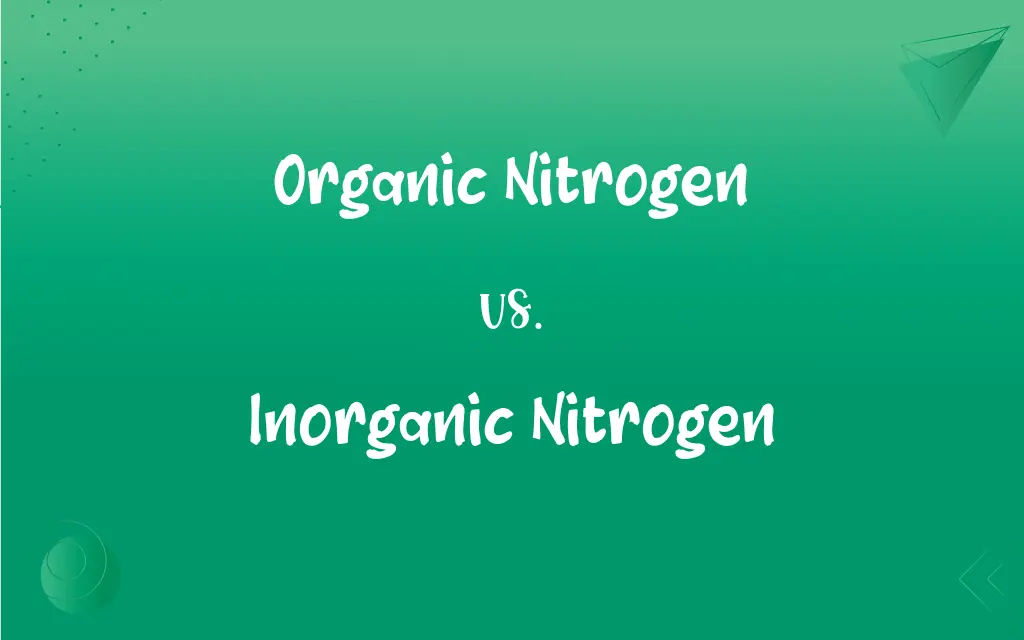Organic Nitrogen vs. Inorganic Nitrogen: What's the Difference?
By Aimie Carlson & Janet White || Published on March 28, 2024
Organic nitrogen is bound within living organisms or organic compounds, while inorganic nitrogen is found in mineral forms, readily available for plant uptake.

Key Differences
Organic nitrogen originates from plant and animal matter, decomposing to enrich the soil, whereas inorganic nitrogen, such as ammonium or nitrate, is directly assimilable by plants. Organic forms are part of the natural cycle, slowly releasing nitrogen as they decompose, which ensures a sustained nutrient supply. In contrast, inorganic nitrogen offers immediate nourishment but can lead to leaching and environmental concerns if misused.
In the realm of agriculture, the choice between organic and inorganic nitrogen sources can significantly impact soil health, plant growth, and ecosystem balance. Organic nitrogen contributes to soil organic matter, improving structure and fertility over time. Inorganic nitrogen, however, can provide plants with a quick nutrient boost, essential for high-yield farming but necessitating careful management to avoid soil degradation and pollution.
The environmental implications of these nitrogen sources are also noteworthy. Organic nitrogen, being part of a slower, natural cycle, tends to have a lower risk of causing eutrophication in water bodies. Inorganic nitrogen, due to its solubility, poses a higher risk of runoff, potentially leading to eutrophication and groundwater contamination.
Comparison Chart
Source
Decomposed plant and animal matter
Synthetic fertilizers, mined minerals
Release Rate
Slow, dependent on decomposition
Fast, immediately available to plants
ADVERTISEMENT
Environmental Impact
Lower risk of leaching, enhances soil health
Higher risk of leaching, can cause eutrophication
Nutrient Availability
Gradual, supports long-term growth
Immediate, supports rapid growth phases
Use in Agriculture
Preferred for sustainable practices
Common in conventional, high-yield farming
Organic Nitrogen and Inorganic Nitrogen Definitions
Organic Nitrogen
Decomposition-derived.
The compost added to the garden slowly releases organic nitrogen as it breaks down.
Inorganic Nitrogen
Synthetically produced.
Ammonium nitrate fertilizer provides inorganic nitrogen for immediate plant uptake.
ADVERTISEMENT
Organic Nitrogen
Soil health enhancer.
Organic nitrogen contributes to the humus content, improving soil structure.
Inorganic Nitrogen
High leaching potential.
Excessive rainfall can wash away inorganic nitrogen, depleting soil fertility.
Organic Nitrogen
Cycling nutrient.
Crop residues left in the field after harvest recycle organic nitrogen back into the soil.
Inorganic Nitrogen
Eutrophication risk.
Runoff from fields using inorganic nitrogen can contribute to algal blooms in nearby water bodies.
Organic Nitrogen
Ecosystem-friendly.
Using organic nitrogen minimizes the risk of waterway pollution from runoff.
Inorganic Nitrogen
Precision farming tool.
Inorganic fertilizers allow for targeted nutrient management, optimizing yields.
Organic Nitrogen
Slow-release.
Organic fertilizers provide a steady supply of nitrogen, avoiding sudden surges in plant growth.
Inorganic Nitrogen
Rapid availability.
Inorganic nitrogen is quickly absorbed by crops, leading to faster growth.
FAQs
What is organic nitrogen?
Organic nitrogen is nitrogen that is bound within organic compounds and living organisms, slowly released into the soil through decomposition.
Why is inorganic nitrogen considered a quick nutrient source?
Inorganic nitrogen is readily available for plant uptake, providing an immediate boost to growth.
What is inorganic nitrogen?
Inorganic nitrogen includes mineral forms like ammonium and nitrate that plants can directly absorb from the soil.
Are there ways to minimize the environmental impact of inorganic nitrogen?
Yes, precise application and timing, along with soil health management, can reduce the environmental risks.
Can using organic nitrogen improve soil health?
Yes, organic nitrogen contributes to soil organic matter, enhancing its structure and fertility over time.
How can inorganic nitrogen cause eutrophication?
When inorganic nitrogen runoff enters water bodies, it can fuel excessive algal growth, depleting oxygen for aquatic life.
How does the rate of release affect the choice between organic and inorganic nitrogen?
The choice depends on the immediate nutrient needs of the crop and the long-term soil management strategy.
How do plants use organic nitrogen?
Plants utilize organic nitrogen after it's mineralized into inorganic forms through the process of decomposition.
Is organic nitrogen slower to benefit plants than inorganic nitrogen?
Yes, organic nitrogen is released more slowly, providing a sustained nutrient supply rather than an immediate boost.
What role does organic nitrogen play in the nitrogen cycle?
Organic nitrogen is a crucial component of the nitrogen cycle, gradually converting to inorganic forms for plant use.
Can the use of organic nitrogen alone meet high crop demand?
While beneficial for soil health, solely relying on organic nitrogen might not meet the rapid nutrient demands of some high-yield crops.
What are the environmental risks of inorganic nitrogen?
Inorganic nitrogen can lead to leaching and eutrophication, posing risks to water quality and ecosystems.
How do weather conditions affect the use of inorganic nitrogen?
Rainfall can increase the risk of leaching, making timing and application methods critical to prevent nitrogen loss.
How does the use of organic nitrogen benefit sustainable farming practices?
It promotes biodiversity, enhances soil life, and reduces dependency on synthetic inputs, aligning with sustainable agriculture principles.
How do regulatory considerations impact the use of inorganic nitrogen?
Regulations may limit the amounts and types of inorganic nitrogen fertilizers to prevent environmental damage, influencing farm management practices.
What are some natural sources of organic nitrogen?
Manure, compost, and green manures are common sources of organic nitrogen.
Can inorganic nitrogen be naturally occurring?
Yes, some inorganic nitrogen compounds are found naturally in the soil, though most agricultural inputs are synthetic.
Can organic and inorganic nitrogen be used together in agriculture?
Combining both can provide immediate and long-term nutrient availability, optimizing plant growth and soil health.
What are the key differences in the application of organic vs. inorganic nitrogen?
Organic nitrogen is typically applied as bulk matter needing decomposition, while inorganic forms are often water-soluble and applied more precisely.
Why is soil testing important in managing nitrogen applications?
Soil tests help determine existing nutrient levels, enabling more accurate and efficient use of both organic and inorganic nitrogen.
About Author
Written by
Aimie CarlsonAimie Carlson, holding a master's degree in English literature, is a fervent English language enthusiast. She lends her writing talents to Difference Wiki, a prominent website that specializes in comparisons, offering readers insightful analyses that both captivate and inform.
Co-written by
Janet WhiteJanet White has been an esteemed writer and blogger for Difference Wiki. Holding a Master's degree in Science and Medical Journalism from the prestigious Boston University, she has consistently demonstrated her expertise and passion for her field. When she's not immersed in her work, Janet relishes her time exercising, delving into a good book, and cherishing moments with friends and family.







































































